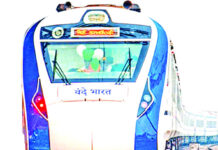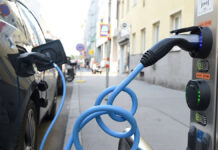Amid apprehensions that infrastructure projects post Union Territory status for Ladakh might affect the ecology of the Himalayan region, its MP Jamyang Tsering Namgyal said future projects will have to be in harmony with the “fragile eco-system” of the region. With nearly a month to go before Ladakh assumes the identity of a UT, the BJP lawmaker said, people of the region need not worry as the process of transition from its current administrative set up to a union territory will be done “very smoothly and effectively”. While a UT status for Ladakh has been a long-standing demand for the people of the region, many locals, both young and old, are apprehensive that new infrastructure projects and mega buildings in hilly areas might damage the ecologically sensitive region. “The Modi government is dynamic and strong, and it has taken a very bold step to carve out a union territory for Ladakh… The concerns of Ladakhis are genuine and we appreciate that. Simultaneously, we are taking their feedback and also incorporating it in our policy-making. “But, whatever scheme or policy that will come to Ladakh (after the UT status), that policy or scheme must be appropriate with the fragile ecosystem of the region, otherwise we are not going to encourage,” Namgyal said. He visited Ladakh on Sunday to attend a convocation ceremony of the first batch of year-long Naropa Fellowship, held at the Hemis Monastery premises, located about 45 km from Leh city. As part of the fellowship, 52 young, dynamic entrepreneurs have come up with several innovative projects across diverse fields to shape the future of the Himalayan region with sustainable solutions. The fellowship was inspired by His Holiness the Gyalwang Drukpa, of Drukpa Buddhist lineage, and co-founded by His Eminence Drukpa Thuksey Rinpoche and educationist Pramath Raj Sinha, who said, it stemmed from “our love for the overwhelming yet fragile beauty of the Himalayas, and our concern about its steady deterioration”. Namgyal, in his address, said the fellowship was introduced for the first time in Ladakh, and such steps were needed for Ladakh’s future as also for the global ecological system. Namgyal had shot to limelight with his impassioned speech in Parliament on abrogation of provisions of Article 370 in Jammu and Kashmir that gave the state a special status. Ladakh currently stands on the brink of a historic change and on October 31, it will officially get the status of a Union Territory. Earlier this month, the Centre had abrogated special status to Jammu and Kashmir and bifurcated the state into two UTs — J&K and Ladakh. Endowed with natural beauty, the removal of special status will open up opportunities for companies to invest in infrastructure projects in the Himalayan region, which many residents, both in Ladakh and J&K are apprehensive about. Namgyal, when asked about people’s concerns on the issue of pressure on ecology, sought to allay the apprehensions, saying, “It depends on our vision, as to how to serve Ladakh, our people and the future generation”. “So, I must welcome investors, but with conditions, like land will not be given in their name; they have to contribute some portion of job opportunities to our local youth; and whatever earning they make from resources, they have to contribute royalty to the council fund to develop the area,” he said. While in Buddhist-dominated Leh district, people are largely happy about the UT status, with some confused or muted in their response, in Muslim-dominated Kargil district of Ladakh, a section of citizens have been protesting the decision. Asked about protests in Kargil, Namgyal claimed “only two per cent is protesting in small markets”. “There is protest, but not in (entire) Kargil. Kargil means nearly 15,000 sq km of land…I agree there have been some protests, but in small markets, and not in all Kargil. Those who have lost their seats or concerned only with political seats will shout.. Otherwise, I can tell, future of Kargil is also bright as that of rest of Ladakh,” he said. Ladakh region is currently divided into two districts — Leh and Kargil, with the district headquarters at Leh city. Both the districts are governed by their own Ladakh Autonomous Hill Development Council (LAHDC), with 26 elected members and four nominated members each. “Ladakh as a UT will not only boost development and future of the region but also give us an identity which is very different, as we have no commonality with Jammu and Kashmir. And, to preserve and promote this unique identity, we will work very tremendously,” Namgyal, who was the former chief executive councillor of the LAHDC in Leh, said. Asserting that Ladakh is strategically located at very important place, bordering China and Pakistan, he said, “so to make a strong and secure nation, Ladakh should have been given the UT status earlier”. “Now, the transition from the current administrative set up to a UT, will be very dynamic. Whether it is vehicle number plates, Aadhaar card addresses, officers from various services… there is no need to worry or be in a hurry. The transition will be done very smoothly and effectively,” the MP said.

Dogra Herald is the media of J & K, breaking language and geographical barriers, connecting J & K to the rest of India.
0191 245 4946
info@dograherald.com
Latest articles
Cyber Police saves Rs 6 lakh lost to ‘RAMA Scam’
iamjkstarr - 0
SRINAGAR: Cyber Police Kashmir today said that for the past one week, Cyber Police Station Kashmir Zone, Srinagar received multiple complaints wherein...
Kashmir zone police establishes helpline number for cases of exigency, assistance
iamjkstarr - 0
SRINAGAR: Kashmir Police on Thursday established a toll-free helpline at Kashmir Police Control Room (PCR) so that one can contact in case...
Jammu and Kashmir records 915 fresh COVID-19 cases, five more deaths
iamjkstarr - 0
JAMMU: Jammu and Kashmir on Sunday recorded 915 fresh COVID-19 cases, including 156 travellers, taking the infection tally to 1,38,390, while five...


























